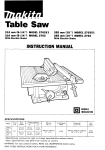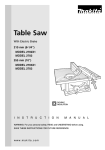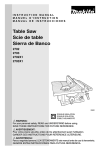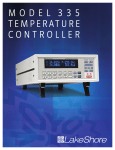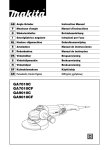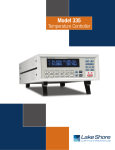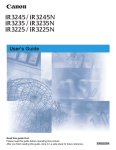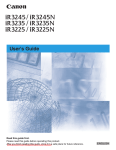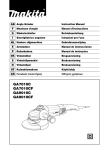Download Makita 2702 Specifications
Transcript
Table Saw 210 m m 2702 2702x1 255m m 2703 2703x1 SPECIFICATIONS Model 2702 2702x1 Blade diameter .......................................... 210 mm Hole (arbor) diameter ................................ 25 mm Cutting capacities ...................................... 90°: 68 mm 45°: 47 mm Table size (W x L) ..................................... 686 mm x 560 mm No load speed (RPM) ............................... 4,600 Dimensions (L x W x H) ............................ 560 mm x 686 mm x 458 mm Net weight ................................................. 18 kg 2703 2703x1 255 mm 25 mm 91 mm 63 mm 686 mm x 560 mm 4,600 560 mm x 686 mm x 458 mm 18 kg Due to the continuing program of research and development, the specifications herein are subject to change without prior notice. Note: Specifications may differ from country to country. Power supply The tool should be connected only to a power supply of the same voltage as indicated on the nameplate, and can only be operated on single-phase AC supply. They are double-insulated in accordance with European Standard and can, therefore, also be used from sockets without earth wire. 3 5 7 4 2 1 1 8 6 2 9 10 11 12 2 1 3 4 13 6 11 15 14 17 11 12 16 5 6 18 19 7 2 8 23 9 20 21 3 22 9 24 25 10 26 27 11 90 90 45 12-A 45 12-B 12 25 30 28 13 29 14 3 32 A B 33 29 31 15 16 34 2 30 35 17 18 19 20 37 18 38 21 4 22 36 40 39 23 24 42 41 41 42 25 26 43 44 45 46 48 47 27 28 51 49 29 50 30 5 Symbols The followings show the symbols used for the tool. Be sure that you understand their meaning before use. ❏ Read instruction manual. ❏ DOUBLE INSULATION 6 ENGLISH Explanation of general view 1 2 3 4 5 6 7 8 9 10 11 12 13 Offset wrench 13-22 Wrench 19 Loosen Inner flange Ring Saw blade Outer flange Hex nut Tighten Blade guard Spreader Pressure plate These two clearances should be equal. 14 Blade guard mounting portion (stay) 15 Hex bolts (A) 16 Hex bolts (B) 17 18 19 20 21 22 23 24 25 26 27 28 29 30 31 32 33 34 5 mm or less Miter gauge Rip fence Lower Raise Handle Lock lever Handwheel Arrow pointer 90° adjusting screw 45° adjusting screw Guide rail Grip Fence holder Scale Hex bolts Adjusting nut Screw SAFETY INSTRUCTIONS Warning! When using electric tools, basic safety precautions should always be followed to reduce the risk of fire, electric shock and personal injury, including the following. Read all these instructions before attempting to operate this product and save these instructions. For safe operation: 1. Keep work area clean Cluttered areas and benches invite injuries. 2. Consider work area environment Don’t expose power tools to rain. Don’t use power tools in damp or wet locations. Keep work area well lit. Don’t use power tools in presence of flammable liquids or gases. 3. Guard against electric shock Prevent body contact with grounded surfaces (e.g. pipes, radiators, ranges, refrigerators). 4. Keep children away Do not let visitors contact tool or extension cord. All visitors should be kept away from work area. 5. Store idle tools When not in use, tools should be stored in dry, high, or locked-up place, out of the reach of children. 6. Don’t force tool It will do the job better and safer at the rate for which it was intended. 7. Use right tool Don’t force small tools or attachments to do the job of a heavy duty tool. Don’t use tools for purposes not intended; for example, don’t use circular saw for cutting tree limbs or logs. 8. Dress properly Do not wear loose clothing or jewelry. They can be caught in moving parts. Rubber gloves and non-skid footwear are recommended when working outdoors. Wear protective hair covering to contain long hair. 9. Use safety glasses and hearing protection Also use face or dust mask if cutting operation is dusty. 10. Connect dust extraction equipment If devices are provided for the connection of dust extraction and collection facilities, ensure these are connected and properly used. 35 36 37 38 39 40 41 42 43 44 45 46 47 48 49 50 51 Scale plate Arrow pointer Groove Knob Push stick Wood or plastic facing Auxiliary fence Push block Rubber cap Leg Under stay Bolt Nut Stay Limit mark Brush holder cap Holder cap opener 11. Don’t abuse cord Never carry tool by cord or yank it to disconnect it from receptacle. Keep cord from heat, oil and sharp edges. 12. Secure work Use clamps or a vise to hold work. It’s safer than using your hand and it frees both hands to operate tool. 13. Don’t overreach Keep proper footing and balance at all times. 14. Maintain tools with care Keep tools sharp and clean for better and safer performance. Follow instructions for lubricating and changing accessories. Inspect tool cords periodically and, if damaged, have repaired by authorized service facility. Inspect extension cords periodically and replace if damaged. Keep handles dry, clean and free from oil and grease. 15. Disconnect tools When not in use, before servicing, and when changing accessories such as blades, bits and cutters. 16. Remove adjusting keys and wrenches Form the habit of checking to see that keys and adjusting wrenches are removed from tool before turning it on. 17. Avoid unintentional starting Don’t carry plugged-in tool with finger on switch. Be sure switch is off when plugging in. 18. Outdoor use extension cords When tool is used outdoors, use only extension cords intended for use outdoors and so marked. 19. Stay alert Watch what you are doing. Use common sense. Do not operate tool when you are tired. 7 20. Check damaged parts Before further use of the tool, a guard or other part that is damaged should be carefully checked to determine that it will operate properly and perform its intended function. Check for alignment of moving parts, binding of moving parts, breakage of parts, mounting, and any other conditions that may affect its operation. A guard or other part that is damaged should be properly repaired or replaced by an authorized service center unless otherwise indicated elsewhere in this instruction manual. Have defective switches replaced by and authorized service center. Do not use tool if switch does not turn it on and off. 21. Warning The use of any other accessory or attachment other than recommended in this operating instruction or the catalog may present a risk of personal injury. 22. Have your tool repaired by an expert This electric appliance is in accordance with the relevant safety rules. Repairing of electric appliances may be carried out only by experts otherwise it may cause considerable danger for the user. 8. 9. 10. 11. 12. 13. 14. ADDITIONAL SAFETY RULES 1. 2. 3. 4. 5. 6. 7. 8 Wear eye protection. Don’t use the tool in presence of flammable liquids or gases. Never use the tool with an abrasive cut-off wheel installed. Check the blade carefully for cracks or damage before operation. Replace cracked or damaged blade immediately. Clean the spindle, flanges (especially the installing surface) and hex nut before installing the blade. Poor installation may cause vibration/ wobbling or slippage of the blade. Use saw-blade guard and spreader for every operation for which it can be used, including all through sawing operations. Through sawing operations are those in which the blade cuts completely through the workpiece as in ripping or cross cutting. Never use the tool with a faulty blade guard or secure the blade guard with a rope, string, etc. Any irregular operation of the blade guard should be corrected immediately. Do not cut metals such as nails and screws. Inspect for and remove all nails, screws and other foreign matter from the workpiece before operation. 15. 16. 17. 18. 19. Remove wrenches, cut-off pieces, etc. from the table before the switch is turned on. Never wear gloves during operation. Keep hands out of the line of saw blade. Do not stand or permit anyone else to stand in line with the path of the saw blade. Make sure the blade is not contacting the spreader or workpiece before the switch is turned on. Before cutting an actual workpiece, let the tool run for a while. Watch for vibration or wobbling that could indicate poor installation or a poorly balanced blade. Use a push stick when required. Push sticks should be used for ripping narrow workpieces to keep your hands and fingers well away from the blade. Pay particular attention to instructions for reducing risk of KICKBACK. KICKBACK is the ejection of the workpiece from the tool back towards the operator. Avoid KICKBACKS by keeping the blade sharp, by keeping the rip fence parallel to the blade, by keeping the spreader, antikickback fingers and blade guard in place and operating properly, by not releasing the workpiece until you have pushed it all the way past the blade, and by not ripping a workpiece that is twisted or warped or does not have a straight edge to guide along the fence. Do not perform any operation freehand. Freehand means using your hands to support or guide the workpiece. Never reach around or over saw blade. Avoid abrupt, fast feeding. Feed as slowly as possible when cutting hard workpieces. Do not bend or twist workpiece while feeding. If you stall or jam the blade in the workpiece, turn the tool off immediately. Unplug the tool. Then clear the jam. Never remove cut-off pieces near the blade or touch the blade guard while the blade is running. Don’t abuse cord. Never yank cord to disconnect from receptacle. Keep cord away from heat, oil, water and sharp edges. SAVE THESE INSTRUCTIONS. OPERATING INSTRUCTIONS The tool is shipped from the factory with the saw blade and blade guard not in the installed condition. Assemble as follows. CAUTION: Always unplug the tool before assembly. Installing saw blade CAUTION: • Use the following saw blade. Do not use saw blades which do not comply with the characteristics specified in these instructions. For Model Max. dia. Min. dia. Blade thickness Kerf 2702 2702x1 210 mm 203 mm 1,4 mm or less 1,6 mm or more 2703 2703x1 260 mm 220 mm 1,8 mm or less 2 mm or more • Check the arbor hole diameter of the blade before installing the blade. Always use the correct ring for the arbor hole of the blade you intend to use. Remove the table insert on the table. Hold the outer flange with the offset wrench 13-22 and loosen the hex nut with the wrench 19. Then remove the outer flange. (Fig. 1) Assemble the inner flange, ring, saw blade, outer flange and hex nut onto the arbor, making sure that the teeth of the blade are pointing down at the front of the table. Always install the hex nut with its recessed side facing the outer flange. (Fig. 2) To secure the blade in place, hold the outer flange with the offset wrench 13-22, then tighten the hex nut with the wrench 19. BE SURE TO TIGHTEN THE HEX NUT SECURELY. (Fig. 3) Installing blade guard CAUTION: Before installing the blade guard, adjust the depth of cut to its maximum elevation. Insert the spreader between the blade guard mounting portion (stay) and the pressure plate. (Fig. 4) Tighten the hex bolts (A) with the offset wrench 13-22. The spreader installing location is factory-adjusted so that the blade and spreader will be in a straight line. However, if they are not in a straight line, loosen the hex bolts (B) and adjust the blade guard mounting portion (stay) so that the spreader is aligned directly behind the blade. Then tighten the hex bolts (B) to secure the stay. (Fig. 5) CAUTION: • Always grasp the striped portion of the offset wrench when tightening the hex bolts. If you tighten the hex bolts while grasping the offset wrench further than the striped portion, the hex bolts may be damaged and/or an injury to your hand may result. • If the blade and spreader are not aligned properly, a dangerous pinching condition may result during operation. Make sure they are properly aligned. There must be a clearance of 5 mm or less between the spreader and the blade teeth. Adjust the spreader accordingly and tighten the hex bolts (A) securely. (Fig. 6) Attach the table insert on the table, then check to see that the blade guard works smooth. Positioning table saw Locate the table saw in a well lit and level area where you can maintain good footing and balance. It should be installed in an area that leaves enough room to easily handle the size of your workpieces. The table saw should be secured with four screws or bolts to the work bench or table saw stand using the holes provided in the bottom of the table saw. When securing the table saw on the work bench, make sure that there is an opening in the top of the work bench the same size as the opening in the bottom of the table saw so the sawdust can drop through. If during operation there is any tendency for the table saw to tip over, slide or move, the work bench or table saw stand should be secured to the floor. NOTE: Table saw stand Model 2702x1/2703x1 are standardequipped with a table saw stand. Leave more than 300 mm clearance between the table and a wall to allow chip ejection. Storing accessory (Fig. 7 & 8) The miter gauge and wrenches can be stored on the left side of the base and the rip fence can be stored at the rear of the base. Adjusting depth of cut (Fig. 9) The depth of cut may be adjusted by turning the handle. Turn the handle clockwise to raise the blade or counterclockwise to lower it. Adjusting bevel angle (Fig. 10) Loosen the lock lever and turn the handwheel until the desired angle (0° – 45°) is obtained. The bevel angle is indicated by the arrow pointer. After obtaining the desired angle, tighten the lock lever to secure the adjustment. 9 Adjusting positive stops The tool is equipped with positive stops at 90° and 45° to the table surface. To check and adjust the positive stops, proceed as follows: Move the handwheel as far as possible by turning it. Place a triangular rule on the table and check to see if the blade is at 90° or 45° to the table surface. (Fig. 11) If the blade is at an angle shown in Fig. 12-A, turn the adjusting screws clockwise; if it is at an angle shown in Fig. 12-B, turn the adjusting screws counterclockwise to adjust the positive stops. (Fig. 12) After adjusting the positive stops, set the blade at 90° to the table surface. Then adjust the arrow pointer so that its right edge is aligned to the 0° graduation. (Fig. 13) Installing and adjusting rip fence Raise the grip of the rip fence. Install the rip fence on the table so that the fence holder engages with the guide rail. The rip fence can be secured by lowering the grip. (Fig. 14) To check to be sure that the rip fence is parallel with the blade, secure the rip fence 2 – 3 mm from the blade. Raise the blade up to maximum elevation. Mark one of the blade teeth with a crayon. Measure the distance (A) and (B) between the rip fence and blade. Take both measurements using the tooth marked with the crayon. These two measurements should be identical. (Fig. 15) If the rip fence is not parallel with the blade, proceed as follows: 1. Turn the adjusting nut counterclockwise a couple of turns. (Fig. 16) 2. Loosen the two hex bolts on the rip fence with the wrench provided. (Fig. 17) 3. Adjust the rip fence until it becomes parallel with the blade. 4. Lower the grip to secure the rip fence. 5. Tighten the two hex bolts on the rip fence. 6. CAUTION: • Always grasp the striped portion of the wrench when tightening the hex bolts. If you tighten the hex bolts while grasping the wrench further than the striped portion, the hex bolts may be damaged and/or an injury to your hand may result. • Be sure to adjust the rip fence parallel with the blade, or a dangerous kickback condition may occur. With the grip of the rip fence lowered, turn the adjusting nut clockwise to secure the rear end of the rip fence. Do not turn the adjusting nut clockwise excessively. You may have some difficulty adjusting the rip fence parallel with the saw blade when repositioning the rip fence. Bring the rip fence up flush against the side of the blade. Make sure that the arrow pointer on the fence holder points to the 0° graduation. If the arrow pointer does not point to the 0° graduation, loosen the screw on the scale plate and adjust the scale plate. (Fig. 18) Switch action (Fig. 19 & 20) To start the tool, depress the “ON” button. To stop the tool, depress the “OFF” button. When depressing the button, it is convenient to view it through the window area in the table. 10 Operation CAUTION: • Always use “work helpers” such as push sticks and push blocks when there is a danger that your hands or fingers will come close to the blade. • Always hold the workpiece firmly. Do not bend or twist it while feeding. If the workpiece is bent or twisted, dangerous kickbacks may occur. • Never withdraw the workpiece while the blade is running. If you must withdraw the workpiece before completing a cut, first switch the tool off while holding the workpiece firmly. Wait until the blade has come to a complete stop before withdrawing the workpiece. Failure to do so may cause dangerous kickbacks. • Never remove cut-off material while the blade is running. • Never place your hands or fingers in the path of the saw blade. Be especially careful with bevel cuts. • Always secure the rip fence firmly, or dangerous kickbacks may occur. • Always use “work helpers” such as push sticks and push blocks when cutting small or narrow workpieces, or when the blade is hidden from view while cutting. Place the workpiece on the table. Switch the tool on without the blade making any contact. Hold the workpiece firmly with both hands and wait until the blade attains full speed. Then gently feed the workpiece into the blade. When cutting hard workpieces, feed them as slowly as possible. To get clean cuts, feed the workpiece straight and at a uniform speed. CAUTION: • Avoid abrupt, fast feeding. Failure to do so may cause overload of the motor, resulting in malfunction of the tool. • Always make sure that the blade guard operates properly to cover the blade before operation. • When cutting thin workpieces, adjust the cut of depth a bit higher than the thickness of the workpiece to obtain a cleaner cut. Crosscutting CAUTION: • When making a crosscut, remove the rip fence from the table. • When cutting long or large workpieces, always provide adequate support to the sides of the table. The support should be at the same height as the table. Miter gauge (Fig. 21) Use the miter gauge when cutting relatively wide workpieces at an angle. Slide the miter gauge into the thick grooves in the table. Loosen the knob on the gauge and align to desired angle (0° to 60°). Bring stock flush up against fence and feed gently forward into the blade. CAUTION: Avoid creep of workpiece and gauge by firm workholding arrangement, especially when cutting at an angle. (Fig. 22) Ripping MAINTENANCE CAUTION: • When ripping, remove the miter gauge from the table. • When cutting long or large workpieces, always provide adequate support behind the table. The support should be at the same height as the table. CAUTION: Always be sure that the tool is switched off and unplugged before carrying out any work on the tool. Switch the tool on and gently feed the workpiece into the blade along with the rip fence. Always use a push stick when there is a danger that your hands or fingers will come close to the blade. (Fig. 23) A facing should be used for operations when the blade comes close to the rip fence. Make a facing from wood board or plastic board. Fasten it to the rip fence with bolts and nuts or glue. (Fig. 24) When the push stick strikes the blade guard because the space between the blade and the rip fence is too narrow, use an auxiliary fence and push block shown in Fig. 25. Clamp the auxiliary fence to the rip fence in two locations. Gently feed the workpiece along the auxiliary fence. When your hand comes close to the blade, rest the push block on the auxiliary fence and feed through until cut is completed. (Fig. 26) Table saw stand NOTE: The following is description only for the tools equipped with a table saw stand. For table saw stands as optional accessories, refer to the instruction manuals for table saw stands provided with them. Place the stays on a level location and assemble the legs inside. Secure with the bolts and nuts, then attach the rubber caps to the ends of the legs. (Fig. 27) Now set the table saw on top of the assembled stand and secure with four hex bolts, washers and hex nuts. (Fig. 28) CAUTION: This is a special stand built precisely for this Makita table saw. Do not use it for other type tools. NOTE: Model 2702x1/2703x1 are standard-equipped with a table saw stand. Inspection • Periodically check tightness of screws carefully. • Make sure that the blade guard operates smooth and properly before operation. Storage Always unplug the tool after operation. Store it in dry, and locked-up place — out of reach of children. When not using it for a long period, take measures to prevent dust and rust. Cleaning Clean out sawdust and chips from time to time. Carefully clean the blade guard and moving parts inside the table saw. Lubrication To keep the table saw in tip-top running condition, and to assure maximum service life, oil or grease the moving parts and rotating parts from time to time. Lubrication places: • Threaded shaft to elevate the blade • Hinge to rotate the frame • Elevation guide shafts on motor • Gear to elevate the blade • Gear to bevel the blade • Shaft to rotate the blade guard • Around slot in steel plate to secure bevel adjustment • Cam shaft of rip fence Replacement of carbon brushes (Fig. 29 & 30) Replace carbon brushes when they are worn down to the limit mark. Both identical carbon brushes should be replaced at the same time. To maintain product safety and reliability, repairs, maintenance or adjustment should be carried out by a Makita Authorized Service Center. ACCESSORIES CAUTION: These accessories or attachments are recommended for use with your Makita tool specified in this manual. The use of any other accessories or attachments might present a risk of injury to persons. Only use accessory or attachment for its stated purpose. If you need any assistance for more details regarding these accessories, ask your local Makita service center. • • • • • • • • • Steel & Carbide-tipped saw blades Sub table set (Left/Right) Rip fence Miter gauge Offset wrench 13-22 Wrench 19 Holder cap opener Joint ( for connecting to dust collector ) Stand set 11 Makita Corporation Anjo, Aichi, Japan 884129B8












